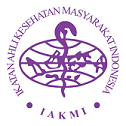Factors associated to stunting children aged 6-24 Months in Yogyakarta
DOI:
https://doi.org/10.12928/promkes.v2i1.1523Keywords:
Stunting, children aged 6-24 months, risk factorsAbstract
Stunting is the impaired growth and development resulting from poor nutrition, repeated infection, and inadequate psychosocial stimulation. Children are defined as stunted if their height-for-age is more than two standard deviations below the WHO Child Growth Standards median. Purwomartani is a village with the highest prevalence of stunting in Kalasan (27.66%), Sleman, Special Region Yogyakarta. The aim of the study was to determine factors that are associated with the incidence of stunting in Purwomartani. Â Observational analytic research was conducted with a case-control design. Data was taken from the Nutrition Monitoring data of Kalasan primary health centre in 2018. Cases were children aged 6-24 months who experienced stunting (n=37). Control was children aged 6-24 months who are not stunted (n=37). Three respondents were excluded from each group. A total of 68 data was analyzed. The results of the study showed that the majority of those who are stunted are in the age groups 13-24 months and the gender was female. Variables related to the incidence of stunting were father's education (OR = 3.429; CI = 1,176-9,994), maternal education (OR = 3,519; CI = 1,270-9,750), birth weight (OR = 5,250; CI = 1,509-18,268) and breastfeeding history (OR = 3.378; CI = 1,246-9,157). Variables that were not related to the incidence of stunting are family income (OR = 1,486; CI = 0,540-4,084), maternal age (OR = 1,170; CI = 0,390-3,512) and birth interval (OR = 2.2750.799-6.476). Â Factors related to stunting were father's education, mother's education, birth weight and history of breastfeeding.
References
2. UNICEF. Ringkasan Kajian Gizi. 2012. Available at: http://www.unicefindonesia.org
3. UNICEF. Improving Child Nutrition. The achievable imperative for global progress. 2013. Available at: http://www.unicef.org.
4. Depkes RI. 2013. Riset Kesehatan Dasar (RISKESDAS). Available at: http://www.depkes.go.id
5. Danaei G, Andrews KG, Sudfeld CR, Fink G, McCoy DC, Peet E, et al. Risk Factors for Childhood Stunting in 137 Developing Countries: A Comparative Risk Assessment Analysis at Global, Regional, and Country Levels. 2016. PLoS Med 13(11): e1002164. doi:10.1371/journal.pmed.1002164
6. Lestari, W., Margawati, A., Rahfiludin, Z. Faktor Risiko Stunting Pada Anak Umur 6-24 Bulan Di Kecamatan Penanggalan Kota Subulussalam Provinsi Aceh. Jurnal Gizi Indonesia. 2014. Vol. 3, No 1: 37-45.
7. Fajrina, Nurul. Hubungan Faktor Ibu Dengan Kejadian Stunting Pada Balita Di Puskesmas Piyungan Kabupaten Bantul. 2016. Available at: http:// www.digilib.unisajogja.ac.id
8. Adriani, M. & Wirjatmadi, B. Gizi dan Kesehatan Balita. Jakarta: Kencana Prenademia Group. 2014.
9. Ngaisiyah, Dewi. Hubungan Sosial Ekonomi Dengan Kejadian Stunting Pada Balita Di Desa Kanigoro, Saptosari, Gunung Kidul. 2015. Jurnal Medika Respati Vol X Nomor 4. http://medika.respati.ac.id.
10. Kemkes RI. Ringkasan Eksekutif Data dan Informasi Kesehtan Provinsi D.I Yogyakarta. 2016. Available at: http://www.pusdatin.kemkes,go.id.
11. Puskesmas Kalasan. Data Pemantauan Status Gizi (PSG) tahun 2017
12. World Health Organization (WHO). Nutrition Landscape Information System (NLIS)
Country Profile Indicators: Interpretation Guide. Geneva: WHO, 2010.
13. Biro Tata Pemerintahan Setda DIY. Jumlah Penduduk Kota Yogyakarta Semester I 2018, Biro Tata Pemerintahan Setda DIY. http://kependudukan.jogjaprov.go.id,
14. Girma W & Genebo T. Determinants of the Nutritional Status of Mothers and
Children in Ethiopia. ORC Macro, Calverton, Maryland, USA. 2002.
15. Hafid, fahmi dan Nasrul. Faktor Risiko Stunting pada Anak Usia 6-23 Bulan di
Kabupaten Jeneponto. indonesian Journal of Human Nutrition, 2016. Vol.3 No.1 Hal : 42 –
53.
16. Eunice, A., dan Sarah, D. An assestment of nutritional status of under five children in four district in the central religion of Ghana. Asian Journal of Agriculture and Rural Development. 2013. vol 3, 851-860
17. Engle, P.L., P. Menon, L. Haddad. Care and Nutrition: Concepts and Measurement. International Food Policy Research Institute. 1997.
18. Walsh AD, Hesketh KD, van der Pligt P, Cameron AJ, Crawford D, Campbell KJ. “Fathers’ perspectives on the diets and physical activity behaviours of their young childrenâ€. Journal Pone. 2017. Vol 12 No 6.
19. Rahayu L.S, Sofyaningsih M. Pengaruh BBLR (Berat Badan Lahir Rendah) dan Pemberian ASI Eksklusif Terhadap Perubahan Status Stunting Pada Balita di Kota dan Kabupaten Tangerang Provinsi Banten. Prosiding Seminar Nasional “Peran Kesehatan Masyarakat dalam Pencapaian MDG’s di Indonesiaâ€; 12 April 2011
20. Mosley WH, Chen LC. Suatu Kerangka Analisis untuk Studi Kelangsungan Hidup Anak di Negara Berkembang, Terjemahan Masri Singarimbun. Gajahmada University Press. Yogyakarta. 1984.
21. Kusuma, K. E., Nuryanto, N. “Faktor Risiko Kejadian Stunting Pada Anak Usia 2-3 Tahun (Studi di Kecamatan Semarang Timur)â€. Journal of Nutrition College, 2013.Vol 2, No 4.
22. Sediaoetama, Achmad Djaeni. Ilmu Gizi untuk Mahasiswa dan Profesi Jilid 1. Cetakan Kesepuluh. Jakarta: Dian Rakyat. 2012.
23. Khomsan. A., Sukandar, Dadang. “Perception of mother’s and childrend’s participation in the national programsâ€. Jurnal gizi dan pangan 2007. Vol 2 No 2 Hal: 26-35.
24. Saaka, Mahama., Galaa, Sylvester Zackaria. Relationships between Wasting and Stunting and Their Concurrent Occurrence in Ghanaian Preschool Children. Journal of Nutrition and Metabolisme. 2016.
25. Upadhyay, Ashish K, and Srivastava S. Effect of Pregnancy Intention, Postnatal Depressive Symptoms and Social Support on Early Childhood Stunting: Findings from India. BMC Pregnancy and Childbirth. 2016.
26. Neupane S, Nwaru BI. “Impact of prenatal care utilization on infant care practices in Nepal: a national representative cross-sectional surveyâ€. Journal Pediatri. 2014. 173(1):99-109. doi: 10.1007/s00431-013-2136-y.
27. Depkes RI. INFODATIN Pusat Data dan Informasi Kementrian Kesehatan Situasi Balita Pendek. 2016. http://www.pusdatin.kemkes.ac.id.
28. Supariasa, D. Dkk. Penilaian Status Gizi. Penerbit Buku Kedokteran EGC: Jakarta. 2002.
29. Barker D. J. P. The origins of the developmental origins theory.Journal of Internal Medicine. 2007 Volume 261, Issue5 Pages 412-417.
30. Giri, M.K.W., Muliarta, I.W., Wahyuni, N.P.D. Hubungan pemberian asi eksklusif dengan status gizi balita usia 6-24 bulan di Kampung Kajanan, Buleleng. Jurnal Sains dan Teknologi, 2013. 2(1), 184-192.
31. Nurastrini, VR.,Kartini A. Jenis Mp-Asi, Frekuensi Dan Waktu Pertama Kalipemberian Mp-Asi Sebagai Faktor Risiko Kejadian Gizi Lebih Pada Bayi Usia 6-12 Bulan Di Kota Magelang Ournal Of Nutrition College, Volume 3, Nomor 1, Tahun 2014, Halaman 259-265.
Downloads
Published
Issue
Section
License
Copyright (c) 2020 Nurul Qomariyah, Fia Amorita Dinasty Putri

This work is licensed under a Creative Commons Attribution-ShareAlike 4.0 International License.
Authors who publish with JCP: Jurnal Cakrawala Promkes agree to the following terms:
- Authors retain copyright and grant the journal the right of first publication with the work simultaneously licensed under a Creative Commons Attribution License (CC BY-SA 4.0) that allows others to share the work with an acknowledgement of the work's authorship and initial publication in this journal.
- Authors are able to enter into separate, additional contractual arrangements for the non-exclusive distribution of the journal's published version of the work (e.g., post it to an institutional repository or publish it in a book), with an acknowledgement of its initial publication in this journal.
- Authors are permitted and encouraged to post their work online (e.g., in institutional repositories or on their website) prior to and during the submission process, as it can lead to productive exchanges, as well as earlier and greater citation of published work.

This work is licensed under a Creative Commons Attribution-ShareAlike 4.0 International License












